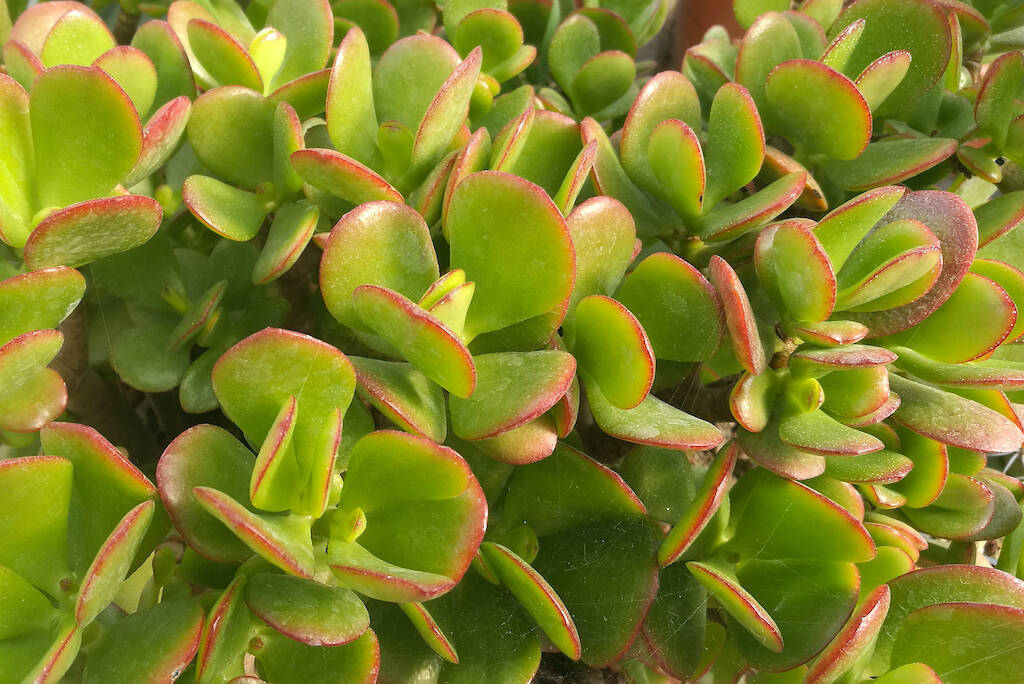Commonly known as the “jade tree” due to the bright green color of its fleshy leaves, or the “money plant” due to the roundish/elongated shape of the leaves, Crassula ovata is a very common succulent plant in cultivation. It can also often be observed in apartments, where it grows well thanks to its great adaptability and where it can add an unexpected touch of green thanks to its sapling habit, with thick and robust brown branches. Crassula ovata is certainly a common plant, not at all sophisticated, and simple in its forms; however, it has its own charm and the ease of cultivation makes it a succulent practically within everyone’s reach.
In the following article we see in detail where it comes from, what are the cultivation needs of this succulent, what are its weaknesses and how it can be successfully reproduced even by those who are beginners in the cultivation of succulent plants. (…)
Description
Crassula ovata belongs to the large Crassulaceae family (also known as the “Borracina family”), made up exclusively of succulent plants. It is the third family in the world in terms of number of species and genera, immediately after that of the Cactaceae and that of the Mesembreyanthemaceae (now Aizoaceae). Just to give a few examples, the Crassulaceae family includes widespread and appreciated genera such as Aeonium, Adromischus, Cotyledon, Echeveria, Graptopetalum, Kalanchoe, Pachyphytum, Sedum and Sempervivum.
Understanding plant classification: a specific article.
With such a wealth of genera, it is not surprising that the Crassulaceae family is widespread in all continents, with the exception of Antarctica, and the plants attributable to it have adapted over the years to conditions of all kinds, from the ones offered by subtropical and tropical areas up to the mountain areas of the Alps (Sempervivum, for example).
Maps with the distribution of succulents in the world.
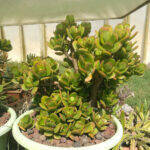
The Crassula genus includes between 250 and 260 species, almost all with thick, fleshy leaves. We can have Crassulas of all shapes and sizes, from herbaceous annuals to arboreal perennials. The provenance of this genus is predominantly African, in particular the southern area of the African continent. The ovata species is probably the best known and most widespread of the entire Crassula genus: it can be seen in cultivation almost everywhere in houses, on windowsills, terraces and gardens. It seems that it has been habitually cultivated as an ornamental for at least a couple of centuries. Once classified as Crassula portulacea, over the years the Crassula ovata forms real saplings which in habitat can reach two and a half meters in height, with very thick and robust brown central trunks, loaded with the characteristic intense green leaves , edged in red if exposed to full sun, which emerge from the many ramifications.
If we grow this plant in sheltered and not very bright environments we will have dark green leaves, while if we expose the already well-formed plants to direct sun we will have light green leaves with a beautiful red border. But be careful: from what I have been able to ascertain, these are plants that should be kept in direct sun only for part of the day. Too many hours of sun risk inhibiting its growth and excessively lightening the leaves until they become yellowish. On the other hand, the cold also contributes to a chromatic variation, which leads the leaves to take on a reddish color over the entire surface.
Cultivation
The cultivation of Crassula ovata is decidedly simple and also suitable for beginners. The plant, as mentioned, has a high adaptability and tolerates many of our mistakes. It can be kept in the apartment or in closed places, as long as it is near a bright window, as well as outdoors in full light for a few hours (preferably in the morning until noon).
The suitable substrate can go from the common mix based on pumice, lapillus and peat in equal parts, to a soil a little richer in organic matter (even 50% peat and 50% various aggregates). Clay is also suitable, provided that a good part of organic matter is added (at least 30% peat or earthworm humus) and aggregates such as gravel, sand, pumice. In summary, the soil must be richer than the one we use for cacti but still loose and draining, able to dry in a few days.
Watering can be frequent and abundant (even once every two or three days in the warmer months) in the growing season and heavily spaced in the autumn and winter months if we keep our Crassula in cold environments. I keep my specimens in the greenhouse with low night temperatures around zero degrees and from November to March, for example, I limit myself to wetting them in moderation only when I see that the leaves begin to wrinkle. If, on the other hand, we grow Crassula at home, in winter it is good to water a few more times, but always in moderation because the plant slows down the vegetation anyway.
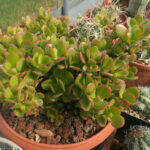
As far as temperatures are concerned, I have seen that if the Crassula spend several nights below zero it is easy for them to start to deteriorate and lose their branches. I guess it’s a defense mechanism that leads the plant to sacrifice the “periphery” to safeguard the “center”. It has happened to me several times, in the past years, that I have had to intervene by cutting cleanly dried branches during the winter, until I have almost completely pruned the plants. Over the course of a growing season, the central part emits new branches and new leaves and returns to full shape, but it is clear that to have large specimens it will take much longer. For some years now I have kept my Crassula in the greenhouse but covered by a couple of layers of non-woven fabric, so that the temperatures do not drop below two or three Celsius degrees on the coldest nights.
The growth of these succulents is relatively fast and, if you water and fertilize regularly during the growing season, within a few years from a simple twig we will have a beautiful shrub which we can also give a tree shape with appropriate pruning (to be done in late spring).
Flowering
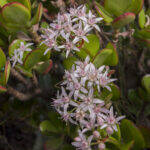
Flowering is winter: generally, in my area (Northern Italy) between the months of November and December. The flowers are small, white and with some pink hues, but all in all inconspicuous. They are very simple and decidedly unattractive when compared to those of other succulent plants, and are collected in inflorescences supported by thin stems that emerge from the grafting of the leaves. The flowers of these plants last a few weeks and this is also thanks to the low temperatures that characterize the flowering period.
Reproduction
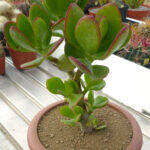
The reproduction of Crassula is very simple and is done almost exclusively by cuttings. In spring, it is sufficient to cut a well-formed branch with a garden shears and let it dry in a shady place for a couple of weeks and then plant it for a few centimeters in very sandy soil (or rich in pumice). For the first two/three weeks it will be sufficient to nebulize both the leaves and the surface of the soil every day, then the substrate can be moderately wet directly. A month later, if we see new leaves appearing, it will mean that the cutting has rooted and we will be able to slightly increase the frequency of watering. The following year it will be possible to repot the new plant in a larger pot and in a soil richer in organic matter. Leaf cuttings can also be made, substantially with the same procedure described above, but I have never tried it directly since the branch cutting obviously ensures much faster development times for the new plant.
Pests and diseases
Crassula is a robust and rustic plant. This does not mean that it doesn’t have its own weak point: in fact it seems to be particularly appreciated by the cottony cochineal, which nestles among the leaves and on the branches, sucking the sap from the plant. For this reason it is always good to keep our specimens under control and, if we identify the cochineal, intervene immediately. If the attack is still contained, it is sufficient to remove the insects with a toothpick, but if the attack is massive, the plant must be immediately isolated and treated with specific products.
Other varieties
Crassula ovata can come in several forms, including some man-made cultivars. The most common variant is the “monstrous” Crassula, also known as the “hobbit” Crassula. It differs from the typical shape for the leaves, which are not wide and flat but almost cylindrical and resemble green “tubes” with reddish ends. The cultivation of the “hobbit” form does not present particular difficulties and is substantially identical to that of the traditional ovata.
SUBSCRIBE TO THE SITE – If you liked this article, subscribe to the site to have access to all the contents for one year or three months depending on the formula you choose. Here you will find terms and conditions.
SUBSCRIBE TO THE NEWSLETTER – If you want to receive the free newsletter every time new content is published (even if you have not subscribed to the site), fill in the fields at this link!
Correlated articles
Succulent plants
Substrates for cacti and succulents
Watering succulents
Classification of succulents
© The texts, videos, photos and graphic elaborations of the site “Il fiore tra le spine” are original material and are covered by copyright. It’s forbidden to reproduce them in any way.


